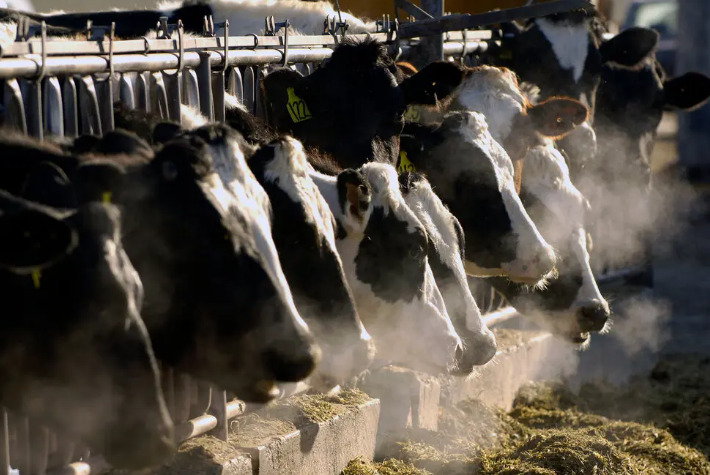
Dr. Sanjay Gupta: Explains the Science of Mouth-Taping
There’s a new sleep trend making waves: taping your mouth shut at night. Advocates say it can help you breathe better, sleep deeper, and even…
Thought Leader: Sanjay Gupta

Federal regulators said on Tuesday that samples of pasteurized milk from around the country had tested positive for inactive remnants of the bird flu virus that has been infecting dairy cows.
The viral fragments do not pose a threat to consumers, officials said. “To date, we have seen nothing that would change our assessment that the commercial milk supply is safe,” the Food and Drug Administration said in a statement.
Over the last month, a bird flu virus known as H5N1 has been detected in more than 30 dairy herds in eight states. The virus is also known to have infected one farmworker, whose only symptom was pink eye.
Scientists have been critical of the federal response, saying that the Agriculture Department has been too slow to share important data and has not adequately pursued the testing of cattle for the infection.
Finding viral fragments in milk from the commercial supply chain is not ideal, but the genetic material poses little risk to consumers who drink milk, said David O’Connor, a virologist at the University of Wisconsin-Madison.
“The risk of getting infected from milk that has viral fragments in it should be nil,” he said. “The genetic material can’t replicate on its own.”
Officials did not say how many samples of pasteurized milk had tested positive for viral fragments or where those samples had come from. Those are key questions, experts said. A minority of the samples tested positive, according to two people with knowledge of the data who were not authorized to speak publicly.
If the fragments are present in many samples throughout the commercial milk supply, it would suggest that the outbreak is likely to be far more widespread than has been believed.
Last week, The New York Times reported that the virus had also been detected in a herd of North Carolina dairy cows that had no symptoms of illness.
“The problem in dairy cows might be much bigger than we know,” Dr. O’Connor said. “That would be the concern — not that the milk itself would be a risk.”
The F.D.A. said that it was studying milk samples from several sources, including infected cows, the milk processing chain and grocery store shelves. Federal officials are still waiting for results from experiments designed to determine whether the milk samples might contain active virus, according to two people familiar with ongoing federal reviews.
Those tests take much longer than so-called PCR tests that determine whether there is viral material in the milk supply.
Federal officials have repeatedly reassured consumers that the commercial milk supply is safe, noting that dairy producers are required to keep milk from sick animals out of the human food supply.
Nearly all of the milk produced on U.S. farms is pasteurized, a process that is designed to kill pathogens with heat. Pasteurization should also inactivate flu viruses, which are known to be fragile and heat-sensitive, experts said.
Only recently has the F.D.A. been testing pasteurization’s effectiveness on H5N1. The risk of contracting the virus from unpasteurized milk products remains unknown, but regulators have long cautioned consumers that raw milk poses a variety of disease risks.
The Centers for Disease Control and Prevention has been monitoring flu testing data and flu-related emergency room visits. “We have not seen anything elevated to date at the local, state or national level,” said Dr. Nirav Shah, the principal deputy director of the agency.
The discovery of viral fragments in milk has prompted significant concern in the White House over how to avoid raising undue alarm about the dairy supply, according to people familiar with internal deliberations who were not authorized to speak publicly.
Federal officials are expected to address the findings in a news briefing in the coming days.
Brian Ronholm, director of food policy at Consumer Reports, an advocacy organization, said that it would be “very critical” for officials to clearly communicate the findings and educate consumers about what they mean.
Milk from farms is already pooled into thousands of gallons that would greatly dilute any virus present. Pasteurization further slashes levels of the virus present.
Soon after the Sept. 11 attacks, Michael Osterholm, an infectious disease expert at the University of Minnesota, helped the federal government plan for a possible bioterrorism attack that might use botulism neurotoxin, a highly lethal pathogen, to contaminate milk.
Working with the dairy industry, he and others identified pasteurization conditions that would inactivate the neurotoxin. That experience reassures him that H5N1 is highly unlikely to pose any problems, Dr. Osterholm said.
“With a virus like this, I would have to believe even if you had the highest levels of virus activity you could ever imagine in the actual milk from the udder of an infected cow, it would be diluted millions of times over going into pasteurization.”
Ingested milk is also broken down by the body’s digestive and immune systems, so “I wouldn’t worry about remnants,” said Dr. Nahid Bhadelia, director of the Boston University Center on Emerging Infectious Diseases.
“As long it’s not a live virus, it is unlikely that there’s any health risks,” she said.
Infected people — and cows — might carry remnants of viral genetic material long after the active infection has resolved. That is why PCR tests for Covid sometimes produce positive results after a person has recovered from illness.
The affected cows seem to have large amounts of virus in their milk, suggesting that it might take some time to become virus-free, Dr. Bhadelia said.
“But the interesting part of this is that we don’t have a sense of how long it takes cows to clear the virus,” she said.
Dr. Sanjay Gupta: Explains the Science of Mouth-Taping
There’s a new sleep trend making waves: taping your mouth shut at night. Advocates say it can help you breathe better, sleep deeper, and even…
Thought Leader: Sanjay Gupta
Joe Grogan: The Alzheimer’s Economic Threat
Social Security could become insolvent in as little as eight years, with more people retiring and living longer and fewer paying into the program. Alzheimer’s disease is…
Thought Leader: Joseph Grogan
Evan Feigenbaum on the outcomes of Putin’s India visit
Evan Feigenbaum of the Carnegie Endowment for International Peace argues that none of India’s major challenges can be meaningfully addressed by deepening ties with Russia.…
Thought Leader: Evan Feigenbaum

